The Economics and Statistics Division maintains archives of previous publications for accountability purposes, but makes no updates to keep these documents current with the latest data revisions from Statistics Canada. As a result, information in older documents may not be accurate. Please exercise caution when referring to older documents. For the latest information and historical data, please contact the individual listed to the right.
<--- Return to Archive
For additional information relating to this article, please contact:
August 18, 2020HOURS WORKED AND LABOUR PRODUCTIVITY, 2019 Statistics Canada has released 2019 preliminary labour productivity accounts for the provinces along with revisions for 2017, 2018 and a small number of series back to 1997. The data is consistent with the provincial gross domestic product (GDP) by industry released in June 2020 with GDP being measured at basic prices.
In 2019, Nova Scotia's labour productivity in the business sector increased by 2.6 per cent following a decrease of 2.7 per cent in 2018 and five consecutive years of growth from 2013 to 2017. Canada's labour productivity in the business sector increased 0.4 per cent in 2019 after growth of 0.2 per cent in 2018, 2.2 per cent in 2017, and 0.4 per cent in 2016. In Nova Scotia, 40.2 dollars (chained 2012) of GDP are produced per hour of work. Nationally, labour productivity in the business sector is 56.6 dollars per hour.
Labour productivity increased 6.2 per cent in Nova Scotia's goods-producing sector and rose 1.1 per cent in the service-producing sector. In Canada, productivity fell in the goods-producing sector by 0.7 per cent while the services-producing sector had an increase of 1.0 per cent.
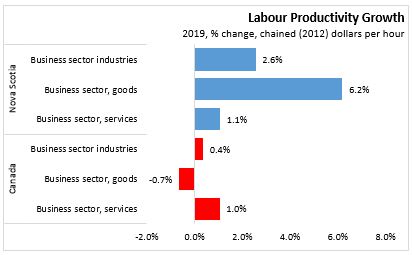
In Nova Scotia, the 2.6 per cent increase in labour productivity was the result of a 2.4 per cent growth in real value added while total hours worked in the economy declined 0.2 per cent. Over the past five years, Nova Scotia's business sector labour productivity has increased by 5.5 per cent and total hours worked have increased 3.0 per cent resulting in a 8.9 per cent increase in real value added.
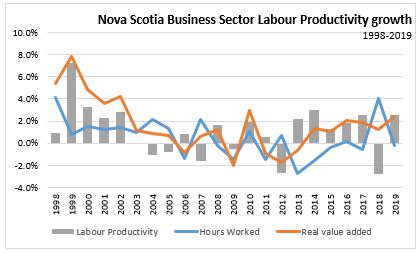

Business sector productivity increased in eight provinces in 2019 with declines in Ontario (-0.6%) and Saskatchewan (-2.7%). The largest labour productivity increases in 2019 were in Atlantic Canada and Quebec.
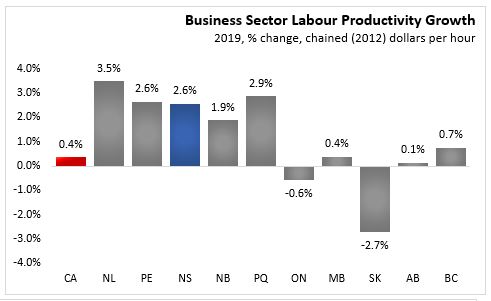
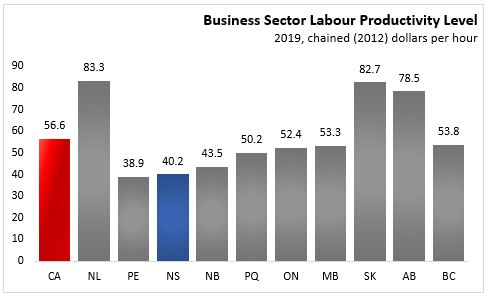
Hours worked in the business sector rose in six provinces in 2019 with the largest increase in Prince Edward Island (+2.6%). Hours worked were lower in Nova Scotia (-0.2%), New Brunswick (-1.2%) and Alberta (-1.5%).
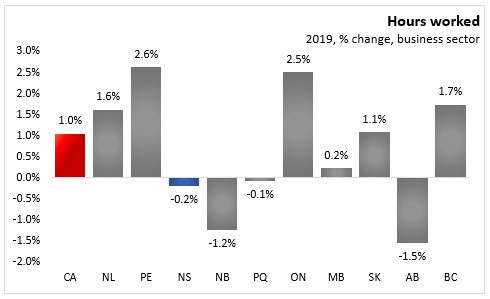
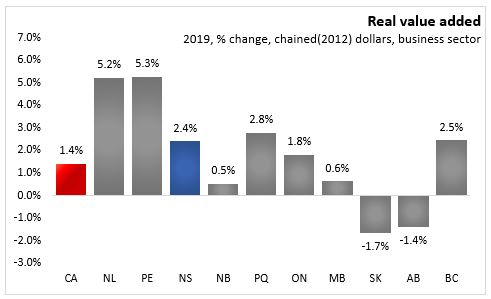
Compensation per hour of work in the business sector was up 5.6 per cent in Nova Scotia to $28.88. Compensation per hour worked was up in all provinces with the largest increases in Quebec (+6.5%) and Nova Scotia (+5.6%). Compensation per hour of work increased 3.3 per cent in Canada in 2019.
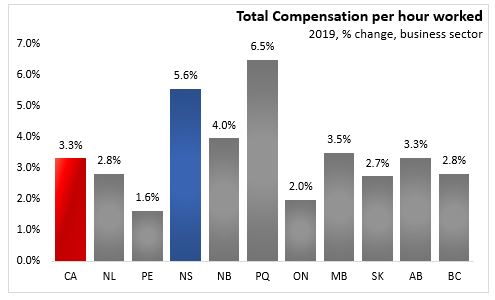

With compensation per hour worked (+5.6 per cent) increasing at a faster pace than labour productivity (+2.6 per cent), the unit labour cost (dollars per unit of real GDP) was up in Nova Scotia by 2.9 per cent in 2019. Unit labour costs were up in eight provinces with declines only in Newfoundland and Labrador (-0.7%) and Prince Edward Island (-1.0%). The Canadian average increased 3.0 per cent, with Saskatchewan (+5.4%) reporting the largest increase.
Unit labour costs in US dollars were up in six provinces with the increase being 0.6 per cent in Canada and Nova Scotia.


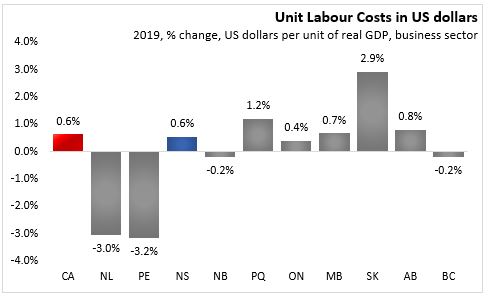
Within Nova Scotia, labour productivity of goods sector was up 6.2 per cent with gains in mining and oil and gas extraction (+18.4%), construction (+9.9%) and manufacturing (+9.7%). Agriculture, forestry, fishing and hunting labour productivity fell 6.1 per cent in 2019 as hours worked rose 8.4 per cent while output was up 2.0 per cent.
Business sector service productivity increased 1.1 per cent in 2019. The fastest growth was in Health care and social assistance -business sector (10.1%), other private services (+7.5%), and educational services - business sector (+5.7%). The largest declines in labour productivity occurred in professional and technical services (-5.4%), administrative, support, wage management and remediation services (-4.1%), and information and cultural services (-3.5%).
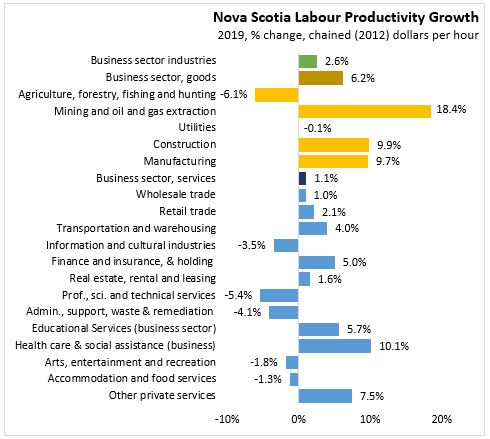
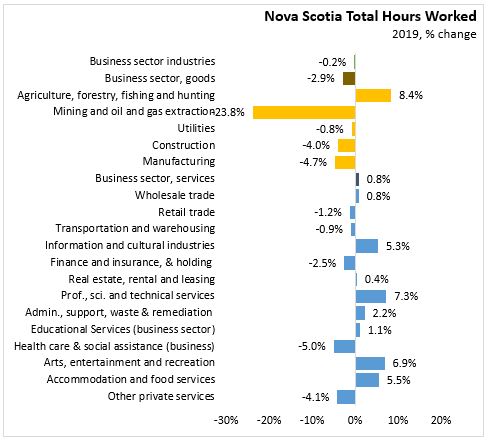
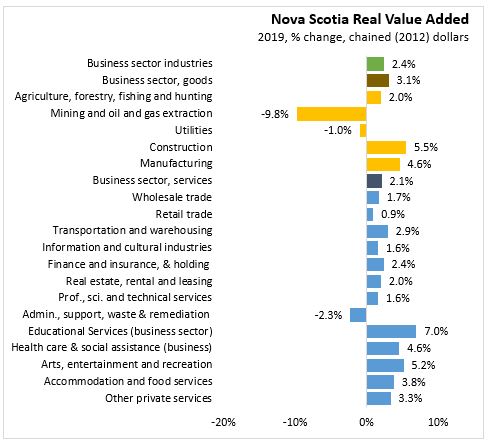
Revisions to Nova Scotia productivity growth rates were most notable in 2016 (+0.3 percentage points) and 2017 (-0.5 percentage points). Overall the total growth rate from 1997 to 2018 has been lowered from 25.2 per cent to 24.8 per cent.
A correction to the Nova Scotia labour productivity data for Real estate, rental and leasing [BS53] and subgrouping of BS53 for 2018 (February 2020 release) has been made with this new release. The sector's labour productivity revised decline is 2.6 per cent in 2018.

Note: Data for educational services and health care and social assistance sectors only includes activity related to the business sector. All figures in this report do not include activity of the non-business sector and government sector.
Source: Statistics Canada. Table 36-10-0480-01 Labour productivity and related measures by business sector industry and by non-commercial activity consistent with the industry accounts
<--- Return to Archive